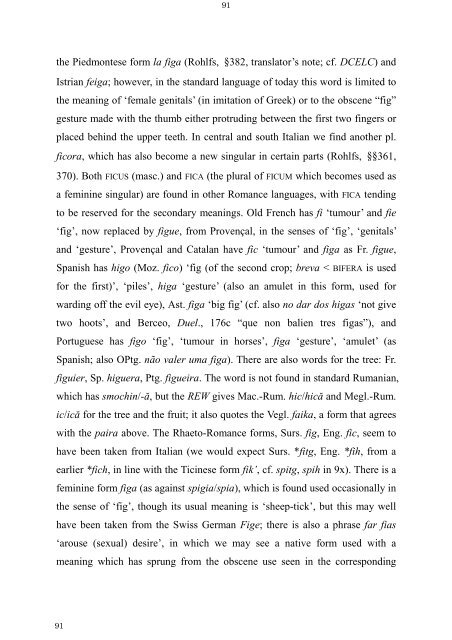The Latin Neuter Plurals in Romance - Page ON
The Latin Neuter Plurals in Romance - Page ON
The Latin Neuter Plurals in Romance - Page ON
Create successful ePaper yourself
Turn your PDF publications into a flip-book with our unique Google optimized e-Paper software.
91<br />
91<br />
the Piedmontese form la figa (Rohlfs, §382, translator’s note; cf. DCELC) and<br />
Istrian feiga; however, <strong>in</strong> the standard language of today this word is limited to<br />
the mean<strong>in</strong>g of ‘female genitals’ (<strong>in</strong> imitation of Greek) or to the obscene “fig”<br />
gesture made with the thumb either protrud<strong>in</strong>g between the first two f<strong>in</strong>gers or<br />
placed beh<strong>in</strong>d the upper teeth. In central and south Italian we f<strong>in</strong>d another pl.<br />
ficora, which has also become a new s<strong>in</strong>gular <strong>in</strong> certa<strong>in</strong> parts (Rohlfs, §§361,<br />
370). Both FICUS (masc.) and FICA (the plural of FICUM which becomes used as<br />
a fem<strong>in</strong><strong>in</strong>e s<strong>in</strong>gular) are found <strong>in</strong> other <strong>Romance</strong> languages, with FICA tend<strong>in</strong>g<br />
to be reserved for the secondary mean<strong>in</strong>gs. Old French has fi ‘tumour’ and fie<br />
‘fig’, now replaced by figue, from Provençal, <strong>in</strong> the senses of ‘fig’, ‘genitals’<br />
and ‘gesture’, Provençal and Catalan have fic ‘tumour’ and figa as Fr. figue,<br />
Spanish has higo (Moz. fico) ‘fig (of the second crop; breva < BIFERA is used<br />
for the first)’, ‘piles’, higa ‘gesture’ (also an amulet <strong>in</strong> this form, used for<br />
ward<strong>in</strong>g off the evil eye), Ast. figa ‘big fig’ (cf. also no dar dos higas ‘not give<br />
two hoots’, and Berceo, Duel., 176c “que non balien tres figas”), and<br />
Portuguese has figo ‘fig’, ‘tumour <strong>in</strong> horses’, figa ‘gesture’, ‘amulet’ (as<br />
Spanish; also OPtg. não valer uma figa). <strong>The</strong>re are also words for the tree: Fr.<br />
figuier, Sp. higuera, Ptg. figueira. <strong>The</strong> word is not found <strong>in</strong> standard Rumanian,<br />
which has smoch<strong>in</strong>/-ă, but the REW gives Mac.-Rum. hic/hică and Megl.-Rum.<br />
ic/ică for the tree and the fruit; it also quotes the Vegl. faika, a form that agrees<br />
with the paira above. <strong>The</strong> Rhaeto-<strong>Romance</strong> forms, Surs. fig, Eng. fic, seem to<br />
have been taken from Italian (we would expect Surs. *fitg, Eng. *fih, from a<br />
earlier *fich, <strong>in</strong> l<strong>in</strong>e with the Tic<strong>in</strong>ese form fik’, cf. spitg, spih <strong>in</strong> 9x). <strong>The</strong>re is a<br />
fem<strong>in</strong><strong>in</strong>e form figa (as aga<strong>in</strong>st spigia/spia), which is found used occasionally <strong>in</strong><br />
the sense of ‘fig’, though its usual mean<strong>in</strong>g is ‘sheep-tick’, but this may well<br />
have been taken from the Swiss German Fige; there is also a phrase far fias<br />
‘arouse (sexual) desire’, <strong>in</strong> which we may see a native form used with a<br />
mean<strong>in</strong>g which has sprung from the obscene use seen <strong>in</strong> the correspond<strong>in</strong>g









